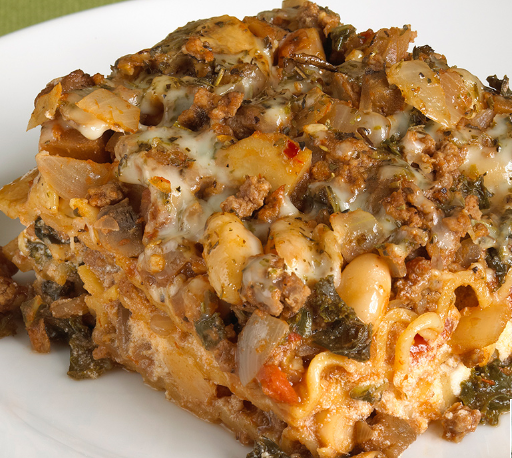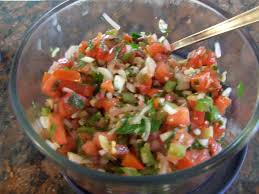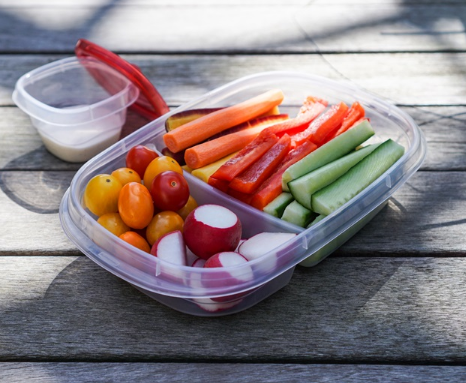
If you would like a more heart-healthy version of this beloved dish, check out the video below.


If you would like a more heart-healthy version of this beloved dish, check out the video below.

How do you meditate while eating? Slow down. Being mindful and paying attention to the food you consume could help you eat healthier, with more appreciation and intention. Learn how to make every meal a practice of awareness.
Mindfulness has become as buzzworthy as cold pressed coffee. One simple way to eat healthier may be to simply be mindful when eating.1
And guess what, mindful eating doesn’t mean dieting or restrictions. It’s about taking a moment to take it in. There are a lot of methods out there, but we’ve simplified it for you.
Ponder: Before you eat, ask yourself, “Am I really hungry?” Sometimes we think we’re hungry when we’re actually thirsty or bored or stressed.2 Check in, do you need nourishment in the form of food or do you need something else?
Appraise: When your food is in front of you, take a moment. How does it look? How does it smell? Do you really want it? Is it more than you need?
Slow: Slow down, like waaay down. Put your fork down between bites. Really chew your food and taste it. Slowing down helps your brain catch up with your stomach.3
Savor: Really enjoy your food. How does the texture feel in your mouth? What are all the complex flavors you can taste? Take a moment to savor the satisfaction of each bite.
Stop: Stop when you’re full. Sounds so obvious, right? But hey, cleaning your plate isn’t necessary. By noticing when you’re full and stopping, you may avoid unnecessary calories and indigestion.
https://healthyforgood.heart.org/be-well/articles/mindful-eating-savor-the-flavor
Now you don’t have to spend hours in the kitchen for the rich flavor of homemade chicken soup. Just add your ingredients to the slow cooker, set it and forget it!
8 Servings
Published December 23, 2015

When the temperatures drop and the daylight hours are shorter, energy levels can take a big dip, right along with mood. Kids might be less active in the cold, winter months, making it extra important to focus on adequate nutrition this time of year. And while it hasn’t been well-studied in children, kids could experience Seasonal Affective Disorder, which is a type of depression with a seasonal pattern, just like adults. Changes in mood, energy, focus, appetite and sleep are some common signs. These foods will help your kids stay healthy — and happy — this winter.
The tryptophan in salmon and other animal proteins is a precursor to serotonin, a neurotransmitter associated with mood regulation. Salmon is also packed with omega-3 fatty acids, which have been shown in some studies to help manage depression. Some kids will eat salmon broiled or grilled — try using a marinade or sauce they love on other foods — or cut the fish into small pieces and make kebabs with veggies.
Clementines are an adorable winter citrus packed with vitamin C and fiber. They also contain calcium, magnesium, phosphorous and potassium for strong bones and good muscle function. Kids love that they’re usually seedless, easy to peel and fun to eat, making them perfect for school lunchboxes or snacks. You can also toss the sections into salads to make greens more appealing.
Winter squash is rich in vitamin A and carotenoids, which have been shown to benefit heart health and immunity while promoting healthy skin. They’re also a good source of fiber, which helps keep blood sugar levels stable.
Lisa Brown, MS, RDN, CDN, a registered dietitian in New York City, encourages parents to make winter squash part of the regular rotation. “Most winter squash varieties are naturally sweet, and what kid doesn’t like sweet? Try roasting butternut squash and tossing with cinnamon and maple syrup,” she says. “You can also mix spaghetti squash with your kid’s favorite pasta sauce.”
Another great source of fiber, sweet potatoes are also packed with vitamin A and potassium. Their mellow, sweet taste works in all kinds of recipes. Slice into thin “coins” and toss with canola or olive oil before roasting. Sweet potato puree can also be used in foods like macaroni and cheese, oatmeal and brownies. Pediatric dietitian Laura Gibofsky, MS, RD, CDN, suggests swapping in baked sweet potatoes as an alternative to french fries. “Have your kids help with peeling so they’re involved in the cooking,” she says.
This member of the cruciferous veggie family has been noted for its high phytochemical content and potential to help prevent cancer and inflammation. Cauliflower is delicious on its own but easily blends with other flavors. It’s rich in vitamins A, C and K, as well as many B-vitamin. But that’s not all. Cauliflower provides a small amount of protein (1.1 gram per serving), plus potassium, magnesium and manganese — important for growth and development — while the fiber promotes stable energy levels and good digestion.
Cauliflower is delicious roasted, but if your kid is averse to eating veggies, Brown has some creative ideas. Try making cauliflower “rice” in a food processor and adding it to stir-fries, she suggests.
“You can also use riced cauliflower for pancakes,” says Brown. “Just microwave for 45 seconds, then blend it into the batter.” Don’t worry, the pancakes don’t taste like cauliflower!
2 cups rolled oats
1½ cups rice cereal
½ teaspoon salt
½ cup peanut butter
4 ounces chopped 60-percent cacao bittersweet chocolate, or ¾ cup chocolate chips
¼ cup coconut oil
¼ cup honey
1 cup (about 5 ounces) dried cherries
Serving size: 1 bar
Serves 28
Calories: 141; Total fat: 7g; Saturated fat: 3g; Cholesterol: 0mg; Sodium: 70mg; Carbohydrates: 19g; Fiber: 2g; Sugars: 9g; Protein: 3g; Potassium: 112mg; Phosphorus: 83mg
Gretchen F. Brown, RD, is a registered dietitian in Watertown, N.Y.

Adding some spice to food may make you more aware of the taste of salt, a new study suggests.
The findings, published Tuesday in the journal Hypertension, indicates that eating spicy foods may help us consume less salt — and, ultimately, lower blood pressure.
According to the World Health Organization, people are eating too much salt across the globe, increasing the prevalence of high blood pressure, heart disease and stroke.
That problem prompted Zhiming Zhu, M.D., a professor of cardiovascular medicine and metabolism at the Chongqing Institute of Hypertension in China, to study alternative ways to reduce salt intake.
He and his colleagues decided to specifically focus on spicy food.
For more information go to: https://news.heart.org/spicy-foods-may-heighten-perception-salt/

We all know we need to be eating more veggies. Some of us love them and eat them at every meal. And then there are those of us who can’t stomach the thought of chomping on something green that looks like a tree. And no, we’re not talking about four-year-olds — we mean adults, too!
Grab a box grater or the grating attachment on your food processor to shred zucchini, beets, carrots or parsnips to add to all sorts of recipes. Add a vegetable serving to your favorite whole grain muffins and quick breads by mixing shredded zucchini into your batter before baking. You can also sauté shredded carrots, summer squash or butternut squash for about five minutes before adding them to pasta sauce for a quick, veggie-filled meal. Even your pickiest of eaters may not notice!
Replace half the ground meat in recipes like burgers, meatloaf and meatballs with cooked chopped mushrooms. Finely chop your choice of mushrooms using a knife or a food processor, then sauté in a little olive oil until soft – about three minutes or so. Once the mushrooms are cool, gently mix them with your lean ground chicken, turkey or beef. Cook thoroughly and follow the recipe as is. Voila! Another veggie-ful meal for the family.
Cooked and pureed orange vegetables like butternut squash, sweet potatoes and carrots can be blended, unnoticed, into cheesy dishes we all love like macaroni and cheese, lasagna, or baked enchiladas. You end up using less cheese, which cuts some of the saturated fat and sodium. You can also add the sweeter-tasting veggies to a blender with some low-sodium broth and puree them into a smooth soup that most kiddos (and adults) will love.
Grab that blender and put it to work! When you’re making your favorite fruit smoothie, add in a frozen banana and some spinach, carrots, squash or just about any vegetable (cooked is easier to blend, FYI). The frozen banana makes for a sweet, thick, and creamy smoothie and it adds a strong banana flavor that helps hide the flavor of the veggies. Want a more colorful smoothie? Try adding beet, avocado or sweet potato to change the tint. You’ll be surprised at how bright – and healthy — your breakfast will be!
Have you successfully snuck veggies past your family before? Tell us about it using #AddColor on our Facebook and Twitter pages.
Healthier Choices Eating Out
https://healthyforgood.heart.org/Eat-mart/Articles/Dining-Out-Doesnt-Mean-Ditch-Your-Diet
LOSE IT |
CHOOSE IT |
|
| bacon, sausage & other fatty, salty meats | skinless chicken, fish, lean meat | |
| white bread, rice and pasta | whole-grain versions | |
| cream-based or cheese soups | broth-based soup with lots of veggies | |
| deep-fried, pan-fried, extra crispy, creamed, stuffed | grilled, sautéed, roasted, steamed, baked, poached | |
| fries | baked potato or side salad | |
| refried beans | pintos or black beans | |
| sour cream, queso | guacamole, pico de gallo | |
| salty sauces like soy, teriyaki, cocktail, au jus | light sauces flavored with herbs, spices, vinegar, wine | |
| all-you-can-eat, supersize, buffet | a la carte, light menu, salad bar | |
| traditional desserts, cookies, ice cream | fresh fruit and fruit-based desserts | |
| regular soda, sweet tea, sugary cocktails | water, 100% juice, diet soda, seltzer, spritzers |
Be prepared when you go out to eat. Healthy choices can be found if you know what to look for and how to ask. Bon appetit!
https://www.thespruce.com/quick-and-easy-cabbage-with-tomato-juice-3052264

So we’re talking about:
Ditch your high-sugar go-to and try:
Guaranteed to fill you right up:
Give these a try:
https://healthyforgood.heart.org/add-color/articles/healthy-snacking